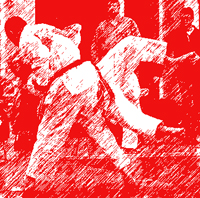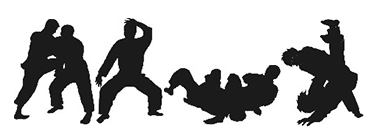Jiu Jitsu
Japanese Jiu-Jitsu is a martial art that encompasses a wide range of techniques, including joint locks, throws, strikes, and grappling. It is taught to police and military personnel throughout the world.
The style we trained in was called Juko Ryu Jiu Jitsu (also called Juko Ryo... likely a translation variation) and was developed from Japanese roots in Britain by Prof. Richard Morris and Robert Clark. Our Sensei is Shihan Tom Sharkey, who was a featured visiting instructor for several years here at our Dojo - teaching Jiu Jitsu on Saturdays from the early-80’s to the mid/late-90’s. Continuing study under Shihan Jack Donovan until he was forced to stop training due to illness and then later passed away.
Currently we are training in a blend of different styles including ground techniques.

Basic Etiquette:
Respect and etiquette are essential in Japanese martial arts. Bowing is a common form of respect, and you should bow when entering and leaving the dojo, as well as when you partner with someone for training.
Warm-up and Stretching:
We begin each training session with a proper warm-up to prepare your body for the physical demands of Jiu-Jitsu. Stretching is crucial to improve flexibility and reduce the risk of injuries.
Fundamental Techniques:
Japanese Jiu-Jitsu includes a wide array of techniques. We learn to safely fall and use basic moves such as strikes, kicks, and blocks. As you progress, you'll learn more advanced techniques like joint locks, throws, and ground control.
Sparring and Randori:
We practice controlled sparring, known as randori, with a training partner. This helps you apply techniques in a more dynamic and realistic setting. It's an essential part of your training to develop practical skills.
Self-Defense Applications:
Japanese Jiu-Jitsu places a strong emphasis on self-defense. Expect to learn techniques that can be applied in real-life situations, such as escaping from holds, defending against multiple attackers, and using everyday objects for self-defense.
Gradings and Belt System:
The belt system in Japanese Jiu-Jitsu signifies your rank and progress. You'll be assessed through gradings, which typically involve demonstrating your proficiency in various techniques.
Consistent Training:
Consistency is key in martial arts. Regularly attend classes, and practice outside of class to reinforce what you've learned.
Respect and Discipline:
Cultivate a mindset of respect and discipline. Treat your fellow students and instructors with courtesy, and adhere to the principles of martial arts both inside and outside the dojo.
History of Jiu Jitsu

Unlike many martial arts, Japanese Jiu-Jitsu has not had a neat and well organized history, therefore its roots have been very difficult to trace. Mentioned as far back as 2500 years ago, Japanese Jiu-Jitsu developed from many individual teachings, either originating in japan or coming to Japan from other Asian countries. The first formal school opened in 1532 in Japan and the art itself became an important part of Samurai training. Jiu-Jitsu is often called the “parent art”, since many other arts like BJJ, Judo and Aikido can trace direct lines to Japanese Jiu-Jitsu.